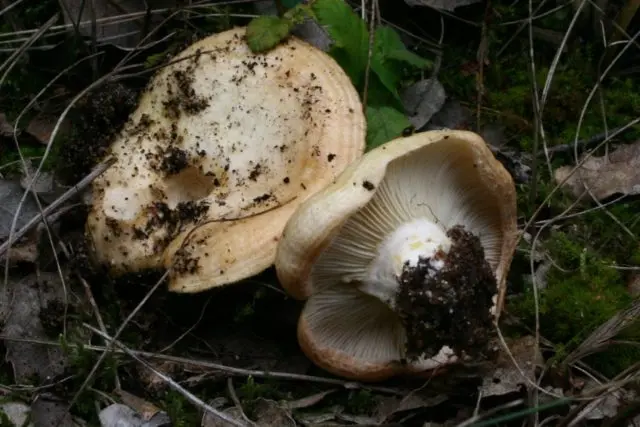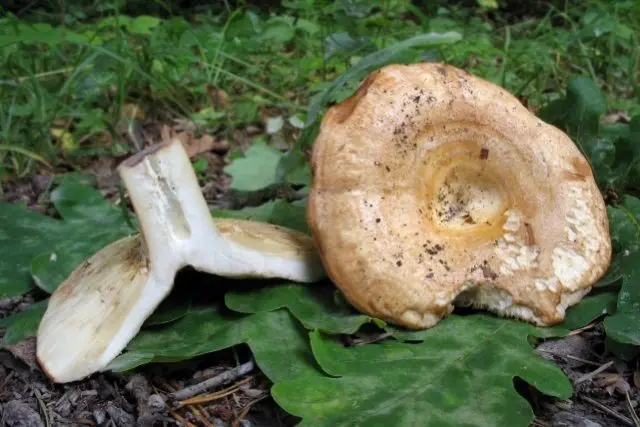Contents
The zonal milker is a representative of the Syroezhkov family, the genus Milky. Also known as milky or oak breast. The Latin name for this species is Lactarius zonarius.
Where does the zonal lactic grow
It is considered a fairly common species, it grows almost everywhere. The zonal mushroom, the photo of which is presented below, prefers broad-leaved forests, forming mycorrhiza with birch, oak, and beech. It can grow both singly and in small groups.
What does a zonal breast look like

Favorable time for the development of this species is the period from July to October.
The fruiting body of the zonal lactifer is presented in the form of a cap and a leg. The cap is very fleshy, reaches 10-15 cm in diameter. At the initial stage of development, it is funnel-shaped, with age it becomes flat with raised and sharp edges. The surface is dry, becomes sticky during the rainy season. Smooth to the touch, always naked. The color varies from cream to ocher shades. In young specimens, thin orange zones can be seen, which disappear with age. Narrow, frequent, descending plates are located from the inner cap. Painted in white or cream color, in rainy weather – reddish.
The foot of the zonal lactic is hard, dry, bare, central, cylindrical in shape. It becomes hollow over time. Smooth to the touch, cream or ocher in color, reddish spots or plaque appear during showers. The pulp is dense, hard, white in young specimens, buffy in mature specimens. On the cut, the color remains unchanged. The zonal milker is characterized by a burning, pungent taste. Has no pronounced odor.

Spore powder is ocher colored
Is it possible to eat a milky zonal
Mlechik zonal belongs to the category of conditionally edible mushrooms. However, eating is recommended only after special processing. One of the necessary steps is to soak the gifts of the forest, since this species has a bitter taste. But it is worth noting that many housewives skip the above steps and simply boil them before cooking.
False doubles
According to external signs, the zonal milker is similar to the following varieties:
- The watery-milky milky is a conditionally edible specimen. Initially, the hat is flat-convex in shape, after a while it becomes goblet-shaped with edges bent inward. It differs from the considered species in the high water content of the milky juice, as well as in darker plates.

- Serushka is considered a conditionally edible mushroom and a fairly common variety in cooking. At the initial stage of maturation, the cap is flat-convex, after a while it becomes funnel-shaped with a noticeable depressed center. It can be distinguished from the zonal milker by its gray color with a lead or pinkish tinge of fruiting bodies. Also, the pulp of the double exudes a spicy mushroom aroma.

- Pine ginger is an edible mushroom and is distinguished by an orange color, it turns red at the break, and then acquires a greenish tint. The taste of the twin is bitter, but exudes a pleasant fruity aroma.

Rules for collection and use
Going in search of a zonal milkweed, it should be remembered that this species grows near hardwood trees, especially near oak and birch. Mushrooms can be located both in groups and one at a time. In order not to damage the mycelium, the leg of each instance should be cut off with a knife. Raw, they are unsuitable for food. However, very tasty dishes can be obtained from this ingredient, but only after pre-treatment. For this you should:
- Clean the zonal milkers from forest debris, cut off the legs.
- Soak the gifts of the forest in a large container, pressing down with oppression from above.
- Soak for 24 hours, while changing the water at least twice.
- Boil the mushrooms without adding salt for about 15 minutes.
After processing, zone milkers can be fried, boiled, pickled.
Conclusion
Despite the fact that the zonal milkweed is not a very popular species among other gifts of the forest, it is suitable for a variety of dishes. These mushrooms are fried, boiled, frozen. According to the hostesses, they are most delicious when salted. But before preparing this or that dish, you need to remember that zonal milkers require preliminary heat treatment to eliminate bitterness.












